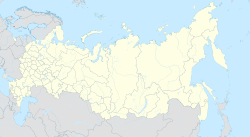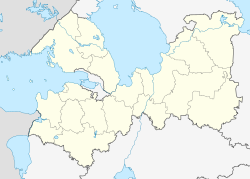world.wikisort.org - Russia
Roshchino (Russian: Ро́щино; Finnish: Raivola), Raivola before 1948, is an urban locality (an urban-type settlement) in Vyborgsky District of Leningrad Oblast, Russia, and a station on the Saint Petersburg-Vyborg railroad. It is situated on the Karelian Isthmus 60 kilometers (37 mi) northwest of St. Petersburg, approximately halfway to Vyborg. Population: 13,439 (2010 Census);[3] 9,393 (2002 Census);[8] 8,436 (1989 Census).[9]
Roshchino
Рощино | |
|---|---|
Urban-type settlement[1] | |
 | |
Location of Roshchino  | |
 Roshchino Location of Roshchino  Roshchino Roshchino (Leningrad Oblast) | |
| Coordinates: 60°14′50″N 29°36′40″E | |
| Country | Russia |
| Federal subject | Leningrad Oblast |
| Administrative district | Vyborgsky District[1] |
| Urban-type settlement status since | 1959[2] |
| Population | |
| • Total | 13,439 |
| • Estimate (2018)[4] | 14,442 (+7.5%) |
Municipal status | |
| • Municipal district | Vyborgsky Municipal District[5] |
| • Urban settlement | Roshchinskoye Urban Settlement[5] |
| • Capital of | Roshchinskoye Urban Settlement[5] |
| Time zone | UTC+3 (MSK |
| Postal code(s)[7] | |
| OKTMO ID | 41615158051 |
| Website | рощино |
In the wooded areas surrounding Roshchino there are multiple marshes and small lakes. Lintula larch forest is located some 3 kilometers (1.9 mi) to the west from the railroad station.
History

Raivola was first shown on maps of Finland in the 16th century.[10] After 1812 it was under jurisdiction of Grand Duchy of Finland being part of Russian Empire, a part of Viipuri Province. The mixed Russian-Finnish population of the area was engaged in agriculture. Around 1802 count Saltykov resettled some 609 of his subjects from Oryol Governorate to the area to meet growing manpower demands for his iron works; in addition to the iron foundry maps of mid-19th century show also sawmill. After the railroad to Helsinki was opened by czar Alexander II in 1870, Raivola was used for changing of locomotive crews. Establishment of the railroad station turned Raivola into a suburb of St. Petersburg and development of the area continued with construction of summer cottages. By the end of the century the population stood around 2,000, of which 169 were Finns. The village had shops, warehouses, two (Finnish and Russian) schools, and Russian Orthodox church of St. Nicholas with a library and medical facility. Also a hydro-electric power station and a telephone station were established. The importance of the local railway station was eclipsed by Terijoki where Finnish customs depot was established in 1911 [11]
In the first quarter of the 20th century Raivola was a summer home (and after 1914 the permanent home) to the Finnish-Swedish family of the young modernist poet Edith Södergran who died there in 1923.
After the Russian October Revolution and independence of Finland, Raivola was recognized as part of Finnish Karelia by articles of the Treaty of Tartu in 1920, while the majority of Russian inhabitants had left. The Soviet Union gained control of Raivola following the Winter War in 1940. The Soviet government's decree of May 28, 1940 provided for establishment of collective farms and resettlement of Russians from Yaroslavl Oblast. Plans of Stalin's government also included forced population transfer of native Finns (116 people, mostly sick and elderly) [12] to Kazakhstan however were disrupted by the Nazi Germany and its Axis allies invasion.

On May 16, 1940 Kannelyarvsky District with the administrative center in the selo of Kanneljärvi was established. It was a part of Leningrad Oblast. On August 22, 1945 the district center was moved from Kannelyarvi to Raivola, and the district was renamed Rayvolovsky. On October 1, 1948 the district was renamed Roshchinsky, and on January 12, 1949 all Finnish names of the localities were replaced with Russian names. In particular, Rayvola was renamed Roshchino. On July 31, 1959 Roshchino was granted urban-type settlement status. On February 1, 1963 Roshchinsky District was abolished and merged into Vyborgsky District.[2]
In 1948, the village again became a Leningrad suburb (the railroad was electrified in 1954) with seasonal swelling of population due to widespread construction of summer cottages, development of privately owned and leased garden plots, establishment of recreational facilities, and youth summer camps.
In 1960, was a monument to Edith Södergran was built.
Lintula Larch Forest
The Lintula Larch Forest (Russian: Корабельная роща, Korabelnaya roshcha, lit. shipbuilding timber grove, or Линдуловская лиственничная роща; Finnish: Lehtikuusimetsä) had a major impact on the cultivation of larch throughout the world and is considered one of the most important cultivated forests in northern Europe.[13] It was established by order of Peter the Great to supply the Russian Navy with shipbuilding timber. Ferdinand Gabriel Fockel, a German forest expert, established the oldest stands in 1738–1750 with seedlings of European Larch (Larix decidua) from the province of Arkhangelsk. Since then the area of the forest has expanded and currently the total area of larch is 55.9 ha (23.5 ha of the 'old stands' established before 1851 still remain).

Possible origins of name
- Two versions explaining the origins of the name Raivola exist: one using Finnish verb raivata, which means "to clean" or "to grub out", and second deriving from the adjective raivo—"mad", possibly alluding to the riding style of Russian coachmen, settled here in time of Peter the Great. The latter version is less likely since the coach station and adjacent residences were located not in Raivola but in neighboring Kivennapa.
- Name Roshchino used after 1948 is derived from "роща" (roshcha, meaning "grove") referring to the Lintula larch grove.
Economy
Transportation
Roshchino railway station is located on the railway line between Saint Petersburg and Vyborg. There is suburban service to the Finland Station in Saint Petersburg.
Roshchino is adjacent to Zelenogorsk and is thus a suburb of Saint Petersburg. It is included in the suburban road network of Saint Petersburg.
References
Notes
- Государственный комитет Российской Федерации по статистике. Комитет Российской Федерации по стандартизации, метрологии и сертификации. №ОК 019-95 1 января 1997 г. «Общероссийский классификатор объектов административно-территориального деления. Код 41 215 558 005», в ред. изменения №278/2015 от 1 января 2016 г.. (State Statistics Committee of the Russian Federation. Committee of the Russian Federation on Standardization, Metrology, and Certification. #OK 019-95 January 1, 1997 Russian Classification of Objects of Administrative Division (OKATO). Code 41 215 558 005, as amended by the Amendment #278/2015 of January 1, 2016. ).
- Каннельярвский район (май 1940 г . - август 1945г.), Райволовский район (август 1945 г. - октябрь 1948 г.), Рощинский район (октябрь 1948 - февраль 1963 г.) (in Russian). Система классификаторов исполнительных органов государственной власти Санкт-Петербурга. Retrieved May 15, 2013.
- Russian Federal State Statistics Service (2011). Всероссийская перепись населения 2010 года. Том 1 [2010 All-Russian Population Census, vol. 1]. Всероссийская перепись населения 2010 года [2010 All-Russia Population Census] (in Russian). Federal State Statistics Service.
- "26. Численность постоянного населения Российской Федерации по муниципальным образованиям на 1 января 2018 года". Federal State Statistics Service. Retrieved January 23, 2019.
- Law #17-oz
- "Об исчислении времени". Официальный интернет-портал правовой информации (in Russian). June 3, 2011. Retrieved January 19, 2019.
- Почта России. Информационно-вычислительный центр ОАСУ РПО. (Russian Post). Поиск объектов почтовой связи (Postal Objects Search) (in Russian)
- Russian Federal State Statistics Service (May 21, 2004). Численность населения России, субъектов Российской Федерации в составе федеральных округов, районов, городских поселений, сельских населённых пунктов – районных центров и сельских населённых пунктов с населением 3 тысячи и более человек [Population of Russia, Its Federal Districts, Federal Subjects, Districts, Urban Localities, Rural Localities—Administrative Centers, and Rural Localities with Population of Over 3,000] (XLS). Всероссийская перепись населения 2002 года [All-Russia Population Census of 2002] (in Russian).
- Всесоюзная перепись населения 1989 г. Численность наличного населения союзных и автономных республик, автономных областей и округов, краёв, областей, районов, городских поселений и сёл-райцентров [All Union Population Census of 1989: Present Population of Union and Autonomous Republics, Autonomous Oblasts and Okrugs, Krais, Oblasts, Districts, Urban Settlements, and Villages Serving as District Administrative Centers]. Всесоюзная перепись населения 1989 года [All-Union Population Census of 1989] (in Russian). Институт демографии Национального исследовательского университета: Высшая школа экономики [Institute of Demography at the National Research University: Higher School of Economics]. 1989 – via Demoscope Weekly.
- Киселев И.В. Райвола на картах. (in proceedings of 1999's conference, Cf below)
- Алексеева О.Б. Станция Райволо-Рощино в составе железной дороги Санкт-Петербург-Риихимяки. (Ibid)
- Балашов Е.А. Райвола: переселенческая политика по обе стороны границы. 1939-1945 гг. (Ibid)
- Redko, Georgi and Eino Mälkönen (2005). The Lintula Larch Forest. Scandinavian Journal of Forest Research 20.3, 252-282.
Sources
- "Райвола-Рощино: История и люди: Материалы науч.конф.", 22-23 сент. 1999 г./ Библ.-инф. центр МО «Выборгский район» Ленинградской области; Сост. и ред. А.Прокопенко—Materials of conference Raivola-Roshchino: History and people, September 22–23, 1999 at Library and Information Center of Vyborg district, A.Prokopenko (Ed.). Includes summaries of most of the proceedings which are available at the Roshchino's website in the "Papers" section).
- Законодательное собрание Ленинградской области. Областной закон №32-оз от 15 июня 2010 г. «Об административно-территориальном устройстве Ленинградской области и порядке его изменения», в ред. Областного закона №23-оз от 8 мая 2014 г. «Об объединении муниципальных образований "Приморское городское поселение" Выборгского района Ленинградской области и "Глебычевское сельское поселение" Выборгского района Ленинградской области и о внесении изменений в отдельные Областные законы». Вступил в силу со дня официального опубликования. Опубликован: "Вести", №112, 23 июня 2010 г. (Legislative Assembly of Leningrad Oblast. Oblast Law #32-oz of June 15, 2010 On the Administrative-Territorial Structure of Leningrad Oblast and on the Procedures for Its Change, as amended by the Oblast Law #23-oz of May 8, 2014 On Merging the Municipal Formations of "Primorskoye Urban Settlement" in Vyborgsky District of Leningrad Oblast and "Glebychevskoye Rural Settlement" in Vyborgsky District of Leningrad Oblast and on Amending Various Oblast Laws. Effective as of the day of the official publication.).
- Законодательное собрание Ленинградской области. Областной закон №17-оз от 10 марта 2004 г. «Об установлении границ и наделении соответствующим статусом муниципальных образований Всеволожский район и Выборгский район и муниципальных образований в их составе», в ред. Областного закона №23-оз от 8 мая 2014 г. «Об объединении муниципальных образований "Приморское городское поселение" Выборгского района Ленинградской области и "Глебычевское сельское поселение" Выборгского района Ленинградской области и о внесении изменений в отдельные Областные законы». Вступил в силу со дня официального опубликования. Опубликован: "Вести", №27, 11 марта 2004 г. (Legislative Assembly of Leningrad Oblast. Oblast Law #17-oz of March 10, 2004 On Establishing the Borders of and Granting an Appropriate Status to the Municipal Formations of Vsevolozhsky District and Vyborgsky District and to the Municipal Formations Comprising It, as amended by the Oblast Law #23-oz of May 8, 2014 On Merging the Municipal Formations of "Primorskoye Urban Settlement" in Vyborgsky District of Leningrad Oblast and "Glebychevskoye Rural Settlement" in Vyborgsky District of Leningrad Oblast and on Amending Various Oblast Laws. Effective as of the day of the official publication.).
External links
- Unofficial website of Roshchino (in Russian)
- Raivola website, sponsored by ProKarelia (in Finnish)
На других языках
[de] Roschtschino (Leningrad)
Roschtschino (russisch Ро́щино) ist eine Siedlung städtischen Typs in der Oblast Leningrad (Russland) mit 13.439 Einwohnern (Stand 14. Oktober 2010).[1]- [en] Roshchino, Leningrad Oblast
[ru] Рощино (Ленинградская область)
Рощино (до 1948 года Райвола, фин. Raivola[3]) — посёлок в Выборгском районе Ленинградской области. Административный центр Рощинского городского поселения.Другой контент может иметь иную лицензию. Перед использованием материалов сайта WikiSort.org внимательно изучите правила лицензирования конкретных элементов наполнения сайта.
WikiSort.org - проект по пересортировке и дополнению контента Википедии